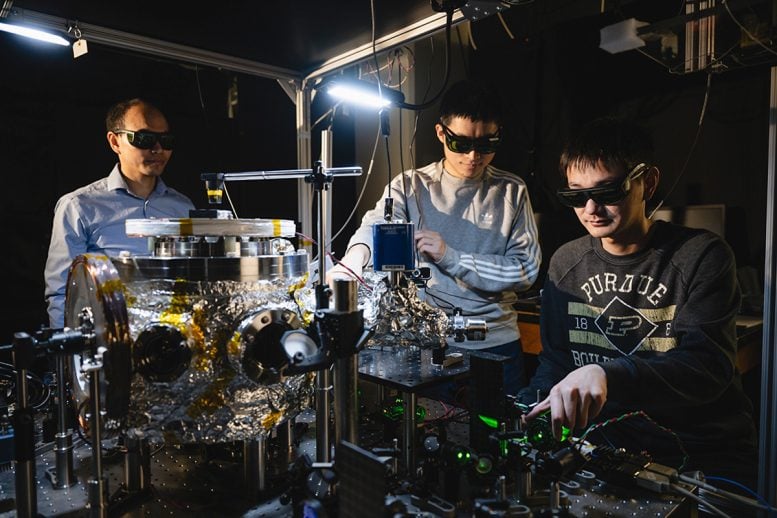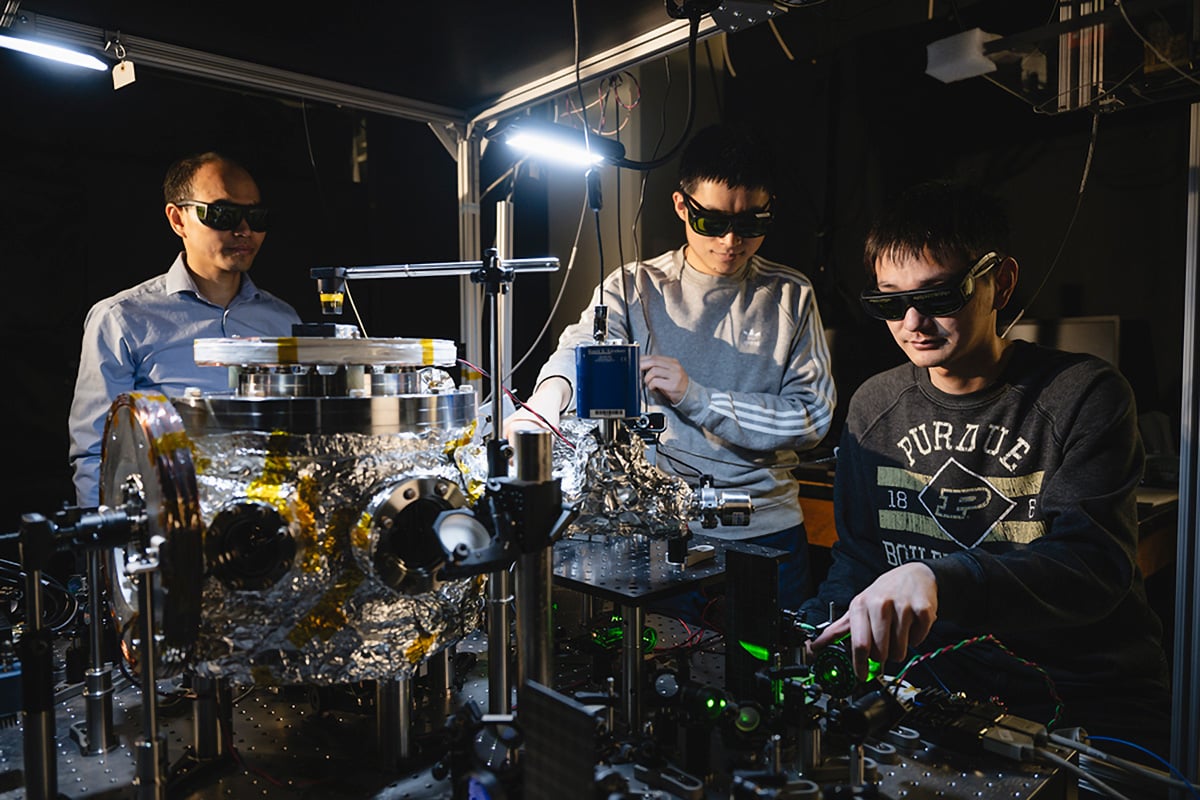
A new milestone in levitating optomechanics was achieved by Prof. Tongcang Li’s group by observing the Berry phase of electron spins in nano-sized diamonds levitated in vacuum.
Physicists at Purdue University are throwing the world’s smallest disco party. The disco ball itself is a fluorescent nanodiamond that they levitate and spin at incredibly high speeds. As the fluorescent diamond spins and shines, it scatters multicolored light in different directions. The party continues as they study the effects of the rapid rotation on the spin qubits in their system and are able to observe the Berry phase.
The team, led by Tongcang Li, professor of physics and astronomy and electrical and computer engineering at Purdue University, published its results in Nature communication. Reviewers of the paper called this work “probably a groundbreaking moment for the study of rotating quantum systems and levitodynamics” and “a new milestone for the levitating optomechanics community.”
“Imagine tiny diamonds floating in empty space or vacuum. Inside these diamonds are spin qubits that allow scientists to make precise measurements and explore the mysterious relationship between quantum mechanics and gravity,” explains Li, who is also a member of the Purdue Quantum Science and Engineering Institute. “In the past, experiments with these floating diamonds have encountered problems in preventing their loss in vacuum and reading out the spin qubits. However, in our work, we successfully levitate a diamond in high vacuum using a special ion trap. For the first time, we were able to observe and control the behavior of the spin qubits inside the floating diamond in high vacuum.”
Observation of the berry phase
The team spun the diamonds incredibly fast—up to 1.2 billion times per minute! This allowed them to observe how the rotation affected the spin qubits in a unique way known as the Berry phase.
“This breakthrough helps us better understand and study the fascinating world of quantum physics,” he says.
The fluorescent nanodiamonds, with an average diameter of about 750 nm, were created by synthesis at high pressure and high temperatures. These diamonds were irradiated with high-energy electrons to create nitrogen-vacancy color centers that house electron spin qubits. When illuminated with a green laser, they emitted red light, which was used to determine their electron spin states. An additional infrared laser was aimed at the levitating nanodiamond to monitor its rotation. Like a disco ball, as the nanodiamond rotated, the direction of the scattered infrared light changed, transmitting the nanodiamond’s rotation information.
The authors of this article are mostly from Purdue University and are members of Li’s research group: Yuanbin Jin (postdoc), Kunhong Shen (graduate student), Xingyu Gao (graduate student), and Peng Ju (recent PhD student). Li, Jin, Shen, and Ju conceived and designed the project, and Jin and Shen built the setup. Jin then performed measurements and calculations, and the team discussed the results together. Two authors not from Purdue University are Alejandro Grine, senior technical associate at Sandia National Laboratories, and Chong Zu, assistant professor at Washington University in St. Louis. Li’s team discussed the experimental results with Grine and Zu, who made suggestions for improving the experiment and the manuscript.
“For the design of our integrated surface ion trap,” explains Jin, “we used a commercial software, COMSOL Multiphysics, to perform 3D simulations. We calculate the trapping position and microwave transmittance using various parameters to optimize the design. We added additional electrodes to conveniently control the motion of a floating diamond. And for the manufacturing, the surface ion trap is fabricated on a sapphire wafer using photolithography. A 300 nm thick gold layer is deposited on the sapphire wafer to create the electrodes of the surface ion trap.”
Control of diamond turning
Which direction do the diamonds spin and can their speed or direction be manipulated? Shen says yes, they can adjust the direction of rotation and the levitation effect.
“We can adjust the drive voltage to change the direction of rotation,” he explains. “The floating diamond can rotate around the Z axis (which is perpendicular to the surface of the ion trap), as shown in the schematic, either clockwise or counterclockwise, depending on our drive signal. If we don’t apply the drive signal, the diamond will spin in all directions, like a ball of wool.”
Levitating nanodiamonds with embedded spin qubits have been proposed for precision measurements and to generate large quantum superpositions to test the limits of quantum mechanics and the quantum nature of gravity.
“General relativity and quantum mechanics are two of the most important scientific breakthroughs of the 20th century.th “We have been working on quantum gravity for some time now, but we still don’t know how gravity could be quantized,” says Li. “The ability to study quantum gravity experimentally would be a huge breakthrough. In addition, rotating diamonds with embedded spin qubits provide a platform to study the coupling between mechanical motion and quantum spins.”
This discovery could have positive implications for industrial applications. Li says that suspended micro- and nanoparticles in a vacuum can serve as excellent accelerometers and electric field sensors. The US Air Force Research Laboratory (AFRL), for example, is using optically suspended nanoparticles to develop solutions to critical problems in navigation and communications.
“At Purdue University, we have state-of-the-art facilities for our research in floating optomechanics,” says Li. “We have two specialized home-built systems dedicated to this area of research. In addition, we have access to the shared facilities of the Birck Nanotechnology Center, which allows us to fabricate and characterize the integrated surface ion trap on campus. We are also fortunate to have talented students and postdocs who are capable of conducting cutting-edge research. In addition, my group has been working in this field for ten years, and our extensive experience has enabled us to make rapid progress.”
Reference: “Quantum control and Berry phase of electron spins in rotating levitating diamonds in high vacuum” by Yuanbin Jin, Kunhong Shen, Peng Ju, Xingyu Gao, Chong Zu, Alejandro J. Grine and Tongcang Li, June 13, 2024, Nature communication.
DOI: 10.1038/s41467-024-49175-3
This research was supported by the National Science Foundation (grant number PHY-2110591), the Office of Naval Research (grant number N00014-18-1-2371), and the Gordon and Betty Moore Foundation (grant number DOI 10.37807/gbmf12259). The project is also supported in part by the Laboratory Directed Research and Development program at Sandia National Laboratories.

